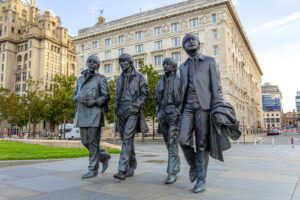The US approach to social enterprise-run assets
Social enterprises across the United States have taken on a wide range of public assets in recent years – from libraries to markets. But what really sets them apart from the UK is their innovative use of taxation, as Gareth Potts explains
Earlier this month Independence Day was celebrated in the United States – the day when, angered by taxation without representation, the 13 American colonies broke free from rule by the Kingdom of Great Britain.
Starting in the early 1980s and intensifying in the last decade, many US community and civic assets have also been set free by their city governments – their management and programming, but not freehold ownership, entrusted to social enterprise. In terms of legal form these are almost invariably charities known as 501(c)(3)s.
All manner of assets have followed this path – including zoos, public markets and golf courses – with almost nothing going in the other direction. Privately managed libraries have grown but have been criticised on costs, ethics, accountability and employee welfare.
Let social enterprise take the reins – it can bring impressive results
Detroit’s Eastern Market, some 200 internal food and flower stalls a mile north east of downtown, is a real civic asset on summer Tuesdays and year-round on Saturdays. It has been galvanised by the transfer of management to a non-profit corporation in 2006. The City still nominates one-third of the board and did issue a $1.5m bond for repairs but has gradually withdrawn funding and control. The corporation must now sustain itself through rents from the food processing companies, wholesalers and retail vendors in and around the market and from foundation, grant money and fund-raising. Food stamps are taken (and matched by a state fund) so lower-income people are also served.
In St Paul, Minnesota, 12 of the city’s older neighbourhood recreation centres were transferred to non-profits several years ago following a competitive process. The break with City management has seen some novel ideas emerge – such as the ‘express yourself’ soccer program run by Joy of the People and inspired by former Brazilian World Cup star Garrincha. The specialist aspect draws kids of all income ranges from across the city – fees are charged but these cover bursaries for those unable to pay. More traditional sports can still use the facilities and are still well served locally.
This is not to say that only social enterprise can deliver assets or that it always works – merely that it is worth considering.
While they may charge fees, social enterprises are meant to do essentially the same as taxpayer-funded services – namely to spread their income in a way that balances covering costs with equity/accessibility. This model is clearly much easier if an asset is well-used and has a reasonably wealthy user base. Where it is not it will need supplementing with taxpayer money and/or others sources such as donations and fundraising.

Future Garrinchas? Kids at the Joy of the People soccer school run from St Anthony Park Rec Center in St Paul, Minnesota
Prosperous Baltimore County, outside the city of the same name, has the best of both worlds – management of many of its leisure facilities are contracted to a YMCA which, as a non-profit, can also raise donations and foundation funds. This is similar to when Greenwich Council’s leisure services were spun-out into and sub-contracted to a (now-famous) employee co-op – it is also an approach now being tried by York’s libraries and archives service.
Sadly, due to budgetary constraints, some US assets are handed over without any contracting or investment.
Use the many tax mechanisms available to come up with more public funds
For many areas of the UK to sustain assets – whether sub-contracted or otherwise – much of the funds in the medium-long term will still need to come from taxes.
The US menu of tax mechanisms used for community and civic assets is extensive. In Detroit the city-owned, nonprofit-run Detroit Institute of Arts (DIA) is supported by a metro-wide ten-year millage (property tax) voted for by public – a bit like a combined authority-level area, this also takes in one of the US’s wealthiest counties. In Minnesota, the arts lobby and ‘great outdoors’ groups collaborated to win a public vote for a 25-year sales tax.
Assets are also supported by taxes on commercial property, income and on sale of goods, services and property. Such votes provide money that is ring-fenced, and which shares the burden on individuals and lessens reliance on any one tax.
On top of this are use of municipal bonds (as used to refurbish four Minneapolis theatres before passing them to non-profit management), tax increment finance (as used to fund Minneapolis’s New Deal for Communities-style Neighborhood Revitalization Program) and tax credits for donations to non-profits that help support assets (as used to help Baltimore’s Parks and People Foundation).
English local authorities can, since 2011, hold a referendum on raising council tax by over 2% – why not have one for assets?
A more entrepreneurial approach to marketing the ‘asset offer’
All assets, however delivered, must promote what they do. US cities have seen some impressive work here.
Detroit’s public library system has eye-catching freeway billboards while the DIA installs replicas of its paintings at strategic locations. There are apps (of Minneapolis public art) and maps (of Baltimore’s Druid Hill Park). In Baltimore kids are engaged through a zoo-mobile that visits schools and an I-Spy booklet on parks. Asset managers can also draw people in – the Detroit Red Wings hockey team hosting a practice at a park rink or the bar-disco and art show in Baltimore’s Walters Art Museum.
Not everything has been expensive – marketing also includes badges and witty sandwich-board signs. Nor has it all been done by government – for example, a Detroit marketing firm, ran a genial pro bono hoax ‘book-burning’ campaign that helped save Troy Library and advanced the firm’s reputation.
The UK isn’t too bad either….
The UK has also had its firsts in terms of asset management – the US lacks anything like the community shares work and the advice on asset transfer from the likes of Locality and Plunkett has no obvious equivalent. There is also no equivalent of Sporta – the national membership association that represents trusts and social enterprises delivering community culture and leisure services.
Some 238 years after a painful split between their two countries, those interested in sustaining assets in the US and UK still have much to compare notes on.



















